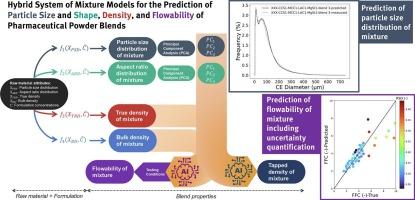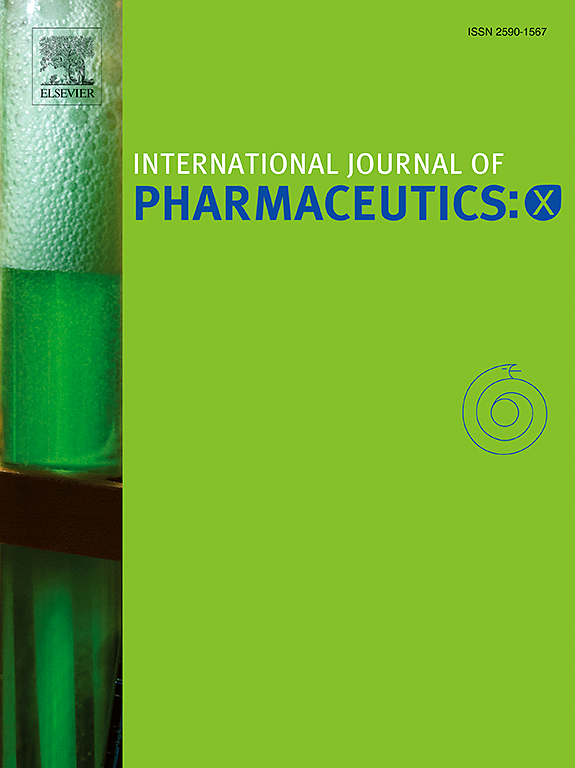用于预测药粉混合物粒度和粒形、密度和流动性的混合模型系统
IF 5.2
2区 医学
Q1 PHARMACOLOGY & PHARMACY
引用次数: 0
摘要
本文介绍了一套混合模型系统,该系统结合了机理和数据驱动方法,可根据原料成分的特性预测粉末混合物的物理特性。本文开发了机理概率模型,利用原料成分的粒度和粒形分布预测药物混合物的粒度和粒形(以长宽比表示)。此外,还对现有混合物规则预测混合物真实密度和体积密度的准确性进行了评估。利用来自 86 种混合物的数据,开发了两种数据驱动模型来估算混合物的挖掘密度和流动性(以流动功能系数 FFC 表示),该模型利用预测粒度和粒形分布的主成分以及真实密度和体积密度作为输入数据,无需对原料成分进行资源密集型剪切测试,从而节省了时间和材料。设计了一种基于模型的不确定性量化技术,用于分析模型预测的 FFC 的精度。所提出的粒度和粒形混合物模型在预测精度方面优于现有方法(分布百分位数加权平均),同时提供了对混合物全面分布的深入了解。所提出的混合模型系统能准确预测不同配方和成分的混合物特性,R2 通常为 0.8,利用原材料特性减少了制备和表征混合物所需的时间和材料资源。本文章由计算机程序翻译,如有差异,请以英文原文为准。

A hybrid system of mixture models for the prediction of particle size and shape, density, and flowability of pharmaceutical powder blends
This paper presents a system of hybrid models that combine both mechanistic and data-driven approaches to predict physical powder blend properties from their raw component properties. Mechanistic, probabilistic models were developed to predict the particle size and shape, represented by aspect ratio, distributions of pharmaceutical blends using those of the raw components. Additionally, the accuracy of existing mixture rules for predicting the blend's true density and bulk density was assessed. Two data-driven models were developed to estimate the mixture's tapped density and flowability (represented by the flow function coefficient, FFC) using data from 86 mixtures, which utilized the principal components of predicted particle size and shape distributions in combination with the true density, and bulk density as input data, saving time and material by removing the need for resource-intensive shear testing for raw components. A model-based uncertainty quantification technique was designed to analyse the precision of model-predicted FFCs. The proposed particle size and shape mixture models outperformed the existing approach (weighted average of distribution percentiles) in terms of prediction accuracy while providing insights into the full distribution of the mixture. The presented hybrid system of models accurately predicts the mixture properties of different formulations and components with often , utilising raw material properties to reduce time and material resources on preparing and characterising blends.
求助全文
通过发布文献求助,成功后即可免费获取论文全文。
去求助
来源期刊

International Journal of Pharmaceutics: X
Pharmacology, Toxicology and Pharmaceutics-Pharmaceutical Science
CiteScore
6.60
自引率
0.00%
发文量
32
审稿时长
24 days
期刊介绍:
International Journal of Pharmaceutics: X offers authors with high-quality research who want to publish in a gold open access journal the opportunity to make their work immediately, permanently, and freely accessible.
International Journal of Pharmaceutics: X authors will pay an article publishing charge (APC), have a choice of license options, and retain copyright. Please check the APC here. The journal is indexed in SCOPUS, PUBMED, PMC and DOAJ.
The International Journal of Pharmaceutics is the second most cited journal in the "Pharmacy & Pharmacology" category out of 358 journals, being the true home for pharmaceutical scientists concerned with the physical, chemical and biological properties of devices and delivery systems for drugs, vaccines and biologicals, including their design, manufacture and evaluation. This includes evaluation of the properties of drugs, excipients such as surfactants and polymers and novel materials. The journal has special sections on pharmaceutical nanotechnology and personalized medicines, and publishes research papers, reviews, commentaries and letters to the editor as well as special issues.
 求助内容:
求助内容: 应助结果提醒方式:
应助结果提醒方式:


